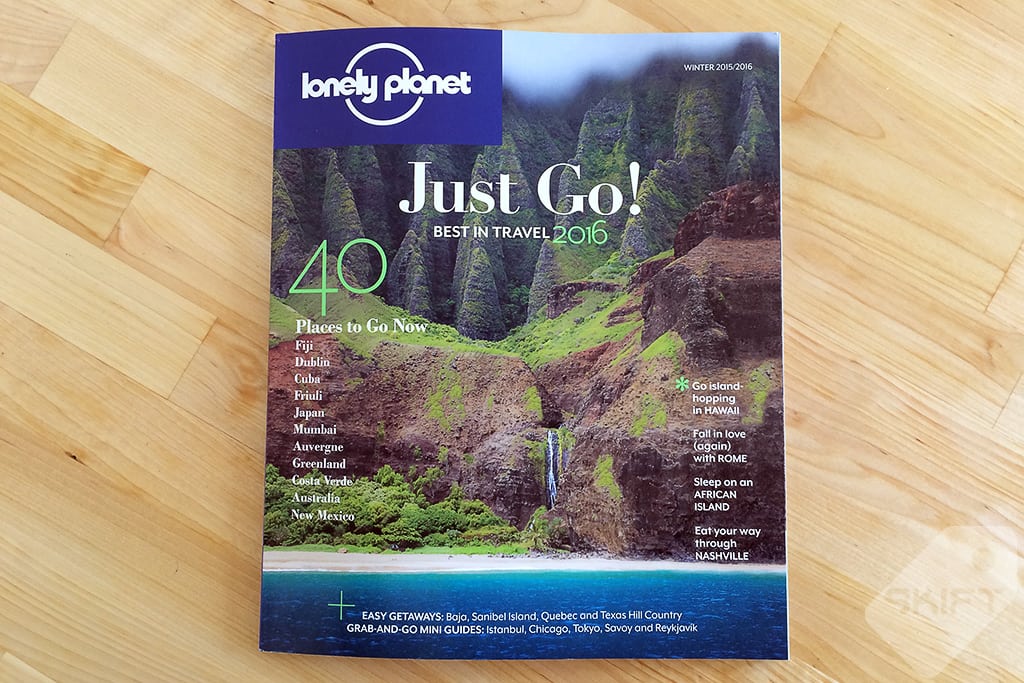Skift Take
The more magazines, the merrier. Let's hope LP moves further in the next issue to add its own distinctive take to the medium.
Lonely Planet’s CEO promised at last year’s Skift Global Forum that the travel brand would launch a magazine in the United States in 2015, and this week a Winter 2015/2016 issue appeared on newsstands and in subscribers’ mailboxes.
The U.S. print magazine in the latest piece of a brand expansion over the last two years that has included the acquisition of an action sports video company and a trip-planning app, among other smaller buys. There are 11 other editions of a Lonely Planet magazine published around the wold.
The magazine was initially slated to debut in early September. At 128 pages it is thin for a quarterly but stands up well to its competitors, especially the waning National Geographic Traveler.
The Insides
The first issue is a destination-focused package centered on the brand’s annual “Best in Travel” list. This year’s list tops last year’s when it comes to quirky picks — Botswana as top country; Transylvania as top region; Kotor, Montenegro as top city — and shows a bit of daring in a “best of” environment that’s become boring and predictable. And like the 2015 pick of Queens, New York as the brand’s top U.S. destination, there are likely to be many very thankful destinations welcoming visitors.
It’s clearly the strongest part of the magazine, and the rest of the publication seems relatively weak in comparison — especially the front of the book. Although LP has contributors scattered across the globe, you don’t get the sense you’re reading advice from experts here. There’s a section called “Easy Trips” that has seven destination profiles without bylines and, instead of driving readers to find out more at LP’s own website, it directs readers to destination marketing organizations’ websites.
The design shows little of the sophistication you’ll find in Lonely Planet’s full-color guidebooks or its UK magazine. Although it’s the same trim size as the recently enlarged Conde Nast Traveler, it doesn’t make use of the real estate to come up with any images that pop, and often pages seem like they’re short on content, rather than just making strategic use of white space.
The handful of people that compare U.S. and UK editions of travel magazines will be familiar with the stark differences between the two. For instance, the UK Lonely Planet title contains clever tear-out mini guides geared toward basic information for short visits to destinations. The U.S. edition has this section, too, but its limited ambitions show in the choice of paper stock. Whereas the UK one is on card stock that’s perforated and ideal to be pulled out, the U.S. edition uses the same thin, glossy paper as the rest of the magazine and a dotted line that says “scissor out” more than “tear out.”
The Business
Advertising is heavy on destination marketing organizations: Visit Portugal, the French half of Belgium, NYC & Company’s family campaign, Rotterdam, Indianapolis, New Zealand and a handful of others take out full-page ads. These sit next to ones from smaller cruise lines, including Viking River Cruises, Avalon Waterways, Uniworld, and Windstar, as well as a content-marketing play by Ford. Considering this is a first issue, the advertising showing is strong.
The magazine is built on the bones of Arthur Frommer’s Budget Travel Magazine. Budget Travel’s 450,000 rate base is being used to deliver the first issue Lonely Planet magazine to U.S. mailboxes. Lonely Planet bought the shuttered magazine’s assets in February 2014 for $2.4 million in an auction. Since then Lonely Planet has kept the BudgetTravel.com website active but has not produced a print or digital version of the magazine. Entry-level subscriptions are priced at $8 for four issues, or $12 if you use a subscription card in the magazine.
The Daily Newsletter
Our daily coverage of the global travel industry. Written by editors and analysts from across Skift’s brands.
Have a confidential tip for Skift? Get in touch
Tags: lonely planet, magazines
Photo credit: The new U.S. edition of Lonely Planet magazine. Skift
